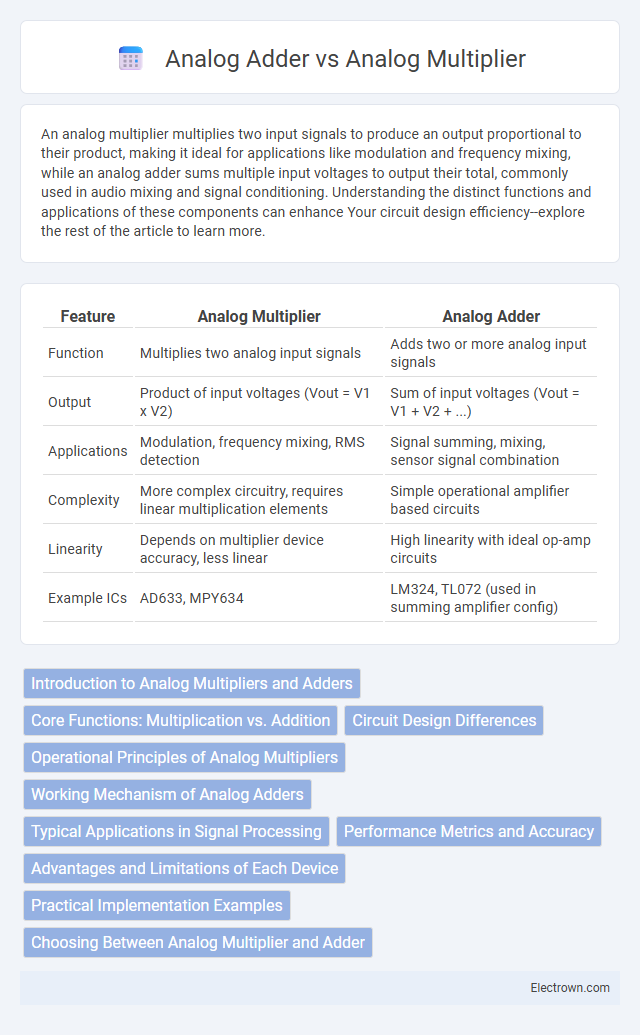An analog multiplier multiplies two input signals to produce an output proportional to their product, making it ideal for applications like modulation and frequency mixing, while an analog adder sums multiple input voltages to output their total, commonly used in audio mixing and signal conditioning. Understanding the distinct functions and applications of these components can enhance Your circuit design efficiency--explore the rest of the article to learn more.
Table of Comparison
| Feature | Analog Multiplier | Analog Adder |
|---|---|---|
| Function | Multiplies two analog input signals | Adds two or more analog input signals |
| Output | Product of input voltages (Vout = V1 x V2) | Sum of input voltages (Vout = V1 + V2 + ...) |
| Applications | Modulation, frequency mixing, RMS detection | Signal summing, mixing, sensor signal combination |
| Complexity | More complex circuitry, requires linear multiplication elements | Simple operational amplifier based circuits |
| Linearity | Depends on multiplier device accuracy, less linear | High linearity with ideal op-amp circuits |
| Example ICs | AD633, MPY634 | LM324, TL072 (used in summing amplifier config) |
Introduction to Analog Multipliers and Adders
Analog multipliers perform real-time multiplication of two analog signals, offering precise output proportional to the product of inputs, essential for modulation and signal processing applications. Analog adders combine multiple input voltages into a single output voltage equal to their sum, commonly used in audio mixing and sensor data aggregation. Your choice between these depends on whether you need to blend signals through summation or generate complex signal interactions via multiplication.
Core Functions: Multiplication vs. Addition
An analog multiplier performs the core function of multiplying two continuous voltage or current signals, producing an output proportional to their product, which is essential in modulation and signal processing applications. An analog adder, on the other hand, sums multiple input signals linearly, combining their amplitudes into a single output, often used in audio mixing and sensor data aggregation. Understanding the differences between multiplication and addition in analog circuitry can help you select the appropriate device for your signal manipulation needs.
Circuit Design Differences
Analog multipliers use complex transistor arrangements or Gilbert cell configurations to perform multiplication by exploiting nonlinear device characteristics, whereas analog adders typically rely on simpler operational amplifier summing circuits that linearly combine input voltages. Multipliers require precise matching of components and often incorporate feedback loops to maintain accuracy over varying temperature and signal conditions. Adders focus on resistor ratios for scaling input signals, resulting in less stringent component tolerances and simpler circuit topologies compared to the inherently nonlinear design of analog multipliers.
Operational Principles of Analog Multipliers
Analog multipliers operate by producing an output voltage proportional to the product of two input signals, using nonlinear components such as transistors or diodes arranged in balanced configurations to achieve accurate signal multiplication. Unlike analog adders that sum input voltages linearly through resistive networks, analog multipliers rely on complex transistor-based circuits that exploit characteristics like transconductance or logarithmic/exponential behaviors for multiplication. Your applications demanding modulation, frequency conversion, or variable gain amplification benefit from the precise operational principle of analog multipliers.
Working Mechanism of Analog Adders
Analog adders operate by summing continuous input voltages through resistive or operational amplifier networks, generating an output voltage proportional to the arithmetic sum of the inputs. The working mechanism relies on linear superposition principles, where each input signal is weighted according to the circuit's resistor ratios, enabling precise additive combination without distortion. Unlike analog multipliers that produce output based on product of inputs, adders maintain linearity, making them essential for signal conditioning and real-time summation tasks in analog signal processing.
Typical Applications in Signal Processing
Analog multipliers are commonly used in modulation, frequency mixing, and signal phase detection, enabling complex operations like amplitude modulation and heterodyning in communication systems. Analog adders excel in summing multiple input signals, often used in audio mixing, sensor data fusion, and feedback control loops to combine or average signals efficiently. Your choice depends on whether the application requires multiplication for modulation and mixing or addition for signal combination and enhancement.
Performance Metrics and Accuracy
Analog multipliers exhibit higher complexity and typically introduce more distortion and noise compared to analog adders, impacting overall signal fidelity. Analog adders offer better linearity and lower error rates, resulting in superior accuracy for summation operations in signal processing applications. Key performance metrics such as total harmonic distortion (THD) and signal-to-noise ratio (SNR) demonstrate that analog adders maintain higher precision and stability across varying input conditions than analog multipliers.
Advantages and Limitations of Each Device
Analog multipliers offer precise signal modulation and amplitude scaling, making them ideal for applications requiring frequency mixing or signal processing. Analog adders excel in simplicity and linearity, providing straightforward voltage summation with minimal distortion, which benefits audio mixing and sensor signal combination. Your choice depends on the need for complex mathematical operations versus simple voltage addition, balancing accuracy, bandwidth, and circuit complexity.
Practical Implementation Examples
Analog multipliers find practical implementation in frequency modulation (FM) synthesis and phase detection within phase-locked loops (PLLs), enabling precise signal modulation and synchronization. Analog adders are commonly used in audio mixing consoles and sensor signal conditioning circuits, allowing for efficient linear combination of multiple input voltages. Both components are integral to analog computing and signal processing, with multipliers manipulating amplitude relationships and adders summing voltage signals.
Choosing Between Analog Multiplier and Adder
Choosing between an analog multiplier and an analog adder depends on the specific signal processing requirements and the desired mathematical operation. Analog multipliers are ideal for applications requiring modulation, frequency mixing, or variable gain, as they multiply two input signals to produce an output proportional to their product. Your choice should consider factors such as signal complexity, accuracy, bandwidth, and the nature of the analog data manipulation needed in circuits or systems.
analog multiplier vs analog adder Infographic

 electrown.com
electrown.com